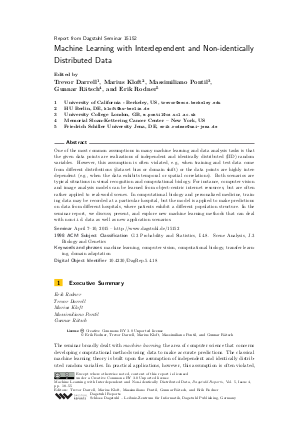Machine Learning with Interdependent and Non-identically Distributed Data (Dagstuhl Seminar 15152)
Authors Trevor Darrell, Marius Kloft, Massimiliano Pontil, Gunnar Rätsch, Erik Rodner and all authors of the abstracts in this report
-
Part of:
Issue:
Dagstuhl Reports, Volume 5, Issue 4
Part of: Volume: Dagstuhl Reports, Volume 5
Part of: Journal: Dagstuhl Reports (DagRep) - License:
 Creative Commons Attribution 3.0 Unported license
Creative Commons Attribution 3.0 Unported license
- Publication Date: 2015-09-18
File

PDF
DagRep.5.4.18.pdf
- Filesize: 1.3 MB
- 38 pages
Document Identifiers
Subject Classification
Keywords
- machine learning
- computer vision
- computational biology
- transfer learning
- domain adaptation
Metrics
- Access Statistics
-
Total Accesses (updated on a weekly basis)
0Document
0Metadata
Abstract
One of the most common assumptions in many machine learning and data analysis tasks is that the given data points are realizations of independent and identically distributed (IID) random variables. However, this assumption is often violated, e.g., when training and test data come from different distributions (dataset bias or domain shift) or the data points are highly interdependent (e.g., when the data exhibits temporal or spatial correlations). Both scenarios are typical situations in visual recognition and computational biology. For instance, computer vision and image analysis models can be learned from object-centric internet resources, but are often rather applied to real-world scenes. In computational biology and personalized medicine, training data may be recorded at a particular hospital, but the model is applied to make predictions on data from different hospitals, where patients exhibit a different population structure. In the seminar report, we discuss, present, and explore new machine learning methods that can deal with non-i.i.d. data as well as new application scenarios.
Cite As Get BibTex
Trevor Darrell, Marius Kloft, Massimiliano Pontil, Gunnar Rätsch, and Erik Rodner. Machine Learning with Interdependent and Non-identically Distributed Data (Dagstuhl Seminar 15152). In Dagstuhl Reports, Volume 5, Issue 4, pp. 18-55, Schloss Dagstuhl – Leibniz-Zentrum für Informatik (2015)
https://doi.org/10.4230/DagRep.5.4.18
BibTex
@Article{darrell_et_al:DagRep.5.4.18,
author = {Darrell, Trevor and Kloft, Marius and Pontil, Massimiliano and R\"{a}tsch, Gunnar and Rodner, Erik},
title = {{Machine Learning with Interdependent and Non-identically Distributed Data (Dagstuhl Seminar 15152)}},
pages = {18--55},
journal = {Dagstuhl Reports},
ISSN = {2192-5283},
year = {2015},
volume = {5},
number = {4},
editor = {Darrell, Trevor and Kloft, Marius and Pontil, Massimiliano and R\"{a}tsch, Gunnar and Rodner, Erik},
publisher = {Schloss Dagstuhl -- Leibniz-Zentrum f{\"u}r Informatik},
address = {Dagstuhl, Germany},
URL = {https://drops.dagstuhl.de/entities/document/10.4230/DagRep.5.4.18},
URN = {urn:nbn:de:0030-drops-53497},
doi = {10.4230/DagRep.5.4.18},
annote = {Keywords: machine learning, computer vision, computational biology, transfer learning, domain adaptation}
}
